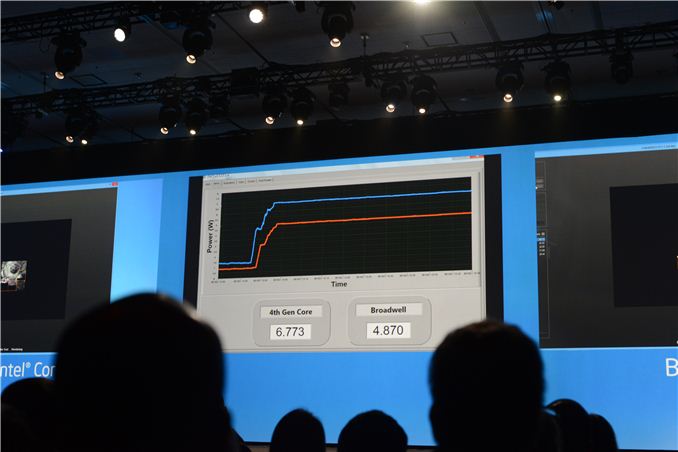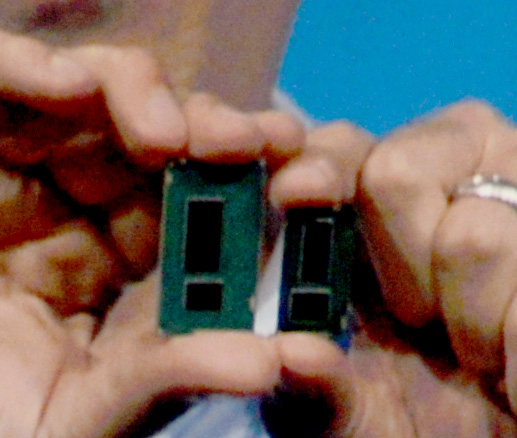Intel Demos 14nm Broadwell: Up to 30% Lower Power than Haswell
by Anand Lal Shimpi on September 11, 2013 12:42 PM EST
Intel just demonstrated 14nm Broadwell ULT (Y-series) silicon, normalized for performance against 22nm Haswell ULT (Y-series) silicon running a multithreaded Cinebench test. Intel was monitoring SoC power during the benchmark and demonstrated a ~30% reduction in power, at the same performance level.
The other reveal? Broadwell ULT, albeit still a two-die, single chip MCM, is physically smaller than Haswell ULT. A physical size reduction is necessary to get Broadwell into fanless tablet designs that can have competitive battery capacities to ARM based designs.

The first Broadwell silicon is supposed to ship to customers by the end of this year, and in systems next year.










38 Comments
View All Comments
The Von Matrices - Wednesday, September 11, 2013 - link
The PCH die on the two packages look remarkably similar. I know it's rumored that that about the only thing the 9 series chipsets will have over the 8 series is SATA express, but are they using the same silicon?Flunk - Wednesday, September 11, 2013 - link
The PCH hasn't really changed much since Intel Integrated the northbridge into the CPU die. The Z68 and Z77 for example are basically identical so it wouldn't be too surprising to see the same thing here.DanNeely - Wednesday, September 11, 2013 - link
Chipset die sizes have been primarily determined by the number of output pins for years. This was the original motivation behind the IGP (FSB, AGP, Ram, and DMI pinouts needing a larger die than their controller hardware did leaving "free" space on the die for something else). The southbridge has been even more static; since it's still just a collection of IO devices and doesn't contain any major computation units.What's interesting to me is that the Broadwell PCH appears slightly larger. It's possible it's just being held slightly closer to the camera (pic's too noisy for me to tell); if not I wonder if SataExpress is the only addition to it. I've been saying for years that if Intel wants to push Thunderbolt below the premium market segment they need to integrate it into their chipsets and am wondering if this might be it.
eanazag - Wednesday, September 11, 2013 - link
This is far more interesting to me than Bay Trail. This is something I might actually buy because the performance is still there. I'm concerned we may not get a performance boost over two years because the power is being cut so dramatically over these two years. I still think it is what Intel needs to do though.Hrel - Wednesday, September 11, 2013 - link
It's Intel. The step down to 14nm is significant. I wouldn't be surprised at all to see a 30% reduction in power AND a 30% increase in performance. Never underestimate their engineers.DanNeely - Wednesday, September 11, 2013 - link
Aside from the GPU, which has gotten significantly more die area, Intel's last few die shrinks have offered negligible performance gains.A5 - Wednesday, September 11, 2013 - link
Intel's been pretty clear that they're worrying primarily about performance per watt more than raw performance since Nehalem, I think. Still a lot of people there bearing the scars of NetBurst.purerice - Saturday, September 14, 2013 - link
You are right. I remember my Pentium4 laptop... It had a jet engine for a cooling fan and got about 90 minutes of battery life without wifi, 70 minutes with. On that note, wifi decreased battery life by 22%.If wifi chip makers (and HD, RAM, etc) did not reduce the power draw of their components as well, we'd see Apple advertise the Macbook Airs as (12 hours with wifi off, or now up to 2 1/2 hours with wifi on)
andykins - Wednesday, September 11, 2013 - link
Erm, no. It's a 30% reduction in power for the SAME CPU performance. I'll eat my hat if Broadwell brings 30% power reduction and 30% increased CPU performance simultaneously. That's not to poo poo Broadwell though, it looks great.MrSpadge - Wednesday, September 11, 2013 - link
Agreed - this is "just a die shrink", so no way for huge benefits in performance and power draw simultanously.